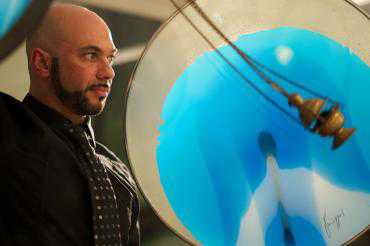A Greek Cypriot glass artist is smashing the boundaries of his chosen field. NAOMI LEACH talks to him about his upcoming joint exhibition, Transparency, to be held in Istanbul

You’d be forgiven for thinking being born on October 28 to a Famagusta family later rendered refugees and then putting together an exhibition with a Turkish artist in Istanbul might make you politically alert but Cypriot glass artist Yorgos Papadopoulos insists that neither he nor his work is politically charged.
Yorgos is forward thinker and an artist firstly, he does not wish his upcoming Turkish exhibition to be about difference, instead he revels in the idea of fraternity and the universal appeal of art.
“I don’t want to get political about this whole idea. I care what happened to Famagusta but I feel I’ve moved on and want to be united with the Turkish people. They are just like the Cypriots and I feel so at home with them. I want to forget about the politics of who did what. I know that I am playing it naively but I respect people’s choice,” he says.
He is aware that his liberal attitudes might not sit well with some Cypriots but he is sensitive to history, admitting his family’s own tale echoes the harrowing stories of other displaced families.
“I took mum over the border here in Cyprus when they first opened. For her everything had changed, seeing things through her eyes was quite dramatic.” After splitting his time between the UK and Cyprus, Yorgos is comfortable with his dual identity and suggests his art goes beyond these definitions.
“It’s not political, it’s not about the past. I am pushing forward to discover new ways to shape glass, to make it more 3D. I am keen to challenge the status quo, particularly of religious institutions afraid of updating their iconography,” he explains.
The religious institution he is referring to is the Church, having created a glasswork collection entitled Virgins which reimagined the usual stained glass imagery seen in churches. The controversial series exhibited in London, New York and Cyprus.
“I used a neon pink florescent colour, trying to break the rules. You can do this and it can still be beautiful. All these priests were there supporting the arts, drinking wine happily and I said I’m willing to donate a piece or two to the church but they wouldn’t accept them,” he says.
Yorgos is not only interested in ruffling the establishment he has also been literally smashing through traditional creative methods of glass art. He has developed a unique technique breaking and relaminating glass to give the impression of fragility to pieces that are actually highly durable.
“I don’t see myself as being part of the glass world because I don’t fit. I take hammers to glass. People say what are you doing but I’m selling my work and make my living from this work. It’s decorative art as opposed to fine art, you can hang it on walls but it’s not paintings.”
Yorgos has created distinctive commissions for British Airways, P&O Cruises and several high profile London restaurants, as well as enjoying a host of international exhibitions. He initially trained in interior design then ceramics at City Lit in London before later making the switch to glass and continuing his studies at the Royal College of Art.
“I fell in love with glass, especially broken glass. I accidentally broke a piece that was laminated and saw its natural beauty. I have developed it ever since. I have a modern approach to stained glass. It’s difficult to pigeon hole. It could be installation, it could be sculptural, it blurs between different boundaries,” he adds.
Like most artists, Yorgos gets attached to his work and admits to finding separation difficult. “They are like my babies, it’s quite an emotional thing to hand a project over for good. When it goes to a lovely home and I get to know the people and can visit, then I’m happy.”
Yorgos has lived in London on and off for 27 years, in the ex council house his family were given by the UK government after leaving Famagusta in 1974. Although he returned to Cyprus during his childhood he was schooled in both countries.
“Cyprus influences my work in some way unconsciously. I spent my childhood there, the light the smells. As soon as I get off the plane I get that dry heat smell and think ‘I remember this’. It comes through my work somehow,” he muses.
Although Cyprus colours some of Yorgos’ work he says he is most inspired at his studio in Spain. Following in the rich tradition of artists with Spanish abodes such as Picasso, Dali and Gaudi, Yorgos has a hilltop studio near Malaga.
“My nearest neighbour is a shepherd. I’m out with the elements. I have a 360 degree view of the mountains and sea. Inspiration comes from natural and organic forms. My hobby is beachcombing, picking up driftwood etc. I love to use my place in Spain for creative, conceptual work. For getting ideas together as a lot of work originates there.”
For bigger projects he uses a glassware studio in Frankfurt, Germany where he busies himself with all the gluing, painting and sanding. He explains that he pre-orders his sandblasted designs and arrives with hammers at the ready to start breaking the glass. He then paints the work before it is sent off to be laminated and polished. Each piece can sell from €11,000 to €17,000.
Yorgos will be exhibiting pieces from both The Virgins collection and his new vibrant Evil Eye project at the Transparency exhibition. Both artists are contributing work on the theme of protection with his co-exhibitor Yasemin Aslan Bakiri’s work depicting shields. The pair met in London, three years ago, at one of Yorgos’ open studio weekends and he promised to bring his work to Yasmin’s Istanbul gallery. Their joint collaboration can be viewed at Balat Mah in Istanbul May 12-July 31.
www.yorgosglass.com

